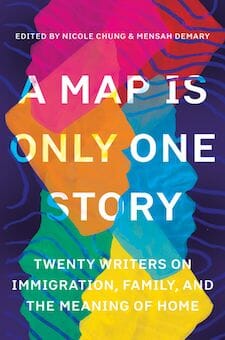A Map Is Only One Story Boasts 20 Must-Read Essays About Immigration

A common refrain in literary circles since the 2016 election is that stories are important—that stories can bridge our differences and reknit bonds. Stories can humanize…but humanize whom? If a story functions to put a human face on something like immigration, this implies the existence of a group who didn’t understand that humanity in the first place.
In other words, who is doing the gazing here? And what does that mean for the stories that are being told?
While reading A Map Is Only One Story, an anthology of essays on immigration edited by Catapult magazine’s editor in chief Nicole Chung and founding editor Mensah Demary, these questions were at the forefront of my (white, non-immigrant) mind. The issue of immigration has been increasingly urgent since the 2016 election, and with that urgency has come a steady flow of narratives that highlight the human cost of policies designed to inflict cruelty. This essay collection catalogs those costs, which range from the emotional to the tangible.
 A Map Is Only One Story includes 20 essays published in Catapult magazine over the last five years, encompassing diverse perspectives and experiences. It opens with Victoria Blanco’s “Why We Cross the Border at El Paso,” a swift reflection on her family’s relationship with the Rio Grande, El Paso and Ciudad Juárez, introducing a juxtaposition between a dominant personal thread and a political and historical undercurrent that is strong throughout many of the essays. In her essay “Arab Past, American Present,” Lauren Alwan writes about what cultural touchstones her Arab grandparents maintained and which ones they let go of in the United States, examining what those choices meant for her own understanding of her Arab-American identity. Cinelle Barnes’ “Carefree White Girls, Careful Brown Girls” documents an attempt at making friends with a white woman, only to see what Barnes herself, as a once undocumented woman of color, had to do in order to stay safe. Some, like Sharine Taylor and Kamna Muddagouni, write through the lens of language. Others, like Nur Nasreen Ibrahim and Steph Wong Ken, write about returning to one’s homeland.
A Map Is Only One Story includes 20 essays published in Catapult magazine over the last five years, encompassing diverse perspectives and experiences. It opens with Victoria Blanco’s “Why We Cross the Border at El Paso,” a swift reflection on her family’s relationship with the Rio Grande, El Paso and Ciudad Juárez, introducing a juxtaposition between a dominant personal thread and a political and historical undercurrent that is strong throughout many of the essays. In her essay “Arab Past, American Present,” Lauren Alwan writes about what cultural touchstones her Arab grandparents maintained and which ones they let go of in the United States, examining what those choices meant for her own understanding of her Arab-American identity. Cinelle Barnes’ “Carefree White Girls, Careful Brown Girls” documents an attempt at making friends with a white woman, only to see what Barnes herself, as a once undocumented woman of color, had to do in order to stay safe. Some, like Sharine Taylor and Kamna Muddagouni, write through the lens of language. Others, like Nur Nasreen Ibrahim and Steph Wong Ken, write about returning to one’s homeland.
The anthology is a moving, deeply personal examination of what it can mean to be an immigrant—or the child of immigrants or even the grandchild of immigrants. But it’s the collection’s final essay, “How to Write Iranian American; or, The Last Essay” by Porochista Khakpour, that makes this more than another collection of stories. Khakpour writes about her own career trajectory and how her early attempts to avoid writing about Iranian America are eventually thwarted as she gains recognition for her personal essays on the subject. She tries to break away from personal essays, but she’s rebuffed by editors who ask her to write about various topics through the lens of her identity. When she complains, a friend tells her she is in part responsible—she’s the one taking the assignments. And while Khakpour acknowledges this, it’s also the only thing she’s being asked to write
To place this essay—explaining how dual identity or immigrant voices are made to stand in for their underrepresented communities in personal essays—at the end of a collection of personal essays by dual identity and immigrant writers turns the tables on the reader. It’s a challenge, a chance to ask ourselves what we came looking for, what we got and what we likely missed.
“They want feelings, not facts,” Khakpour writes after being denied a reporting assignment in favor of yet another personal essay. The identity of “they” is just ambiguous enough; is it the editor, the publication, the reader? Is there effectively any difference between those three?
What is published is what they—we—read and discuss. A Map Is Only One Story reminds readers that the collective gaze isn’t passive. It has power to connect as well as to limit.
Bridey Heing is a freelance writer based in Washington, DC. More of her work can be found on her website.







































